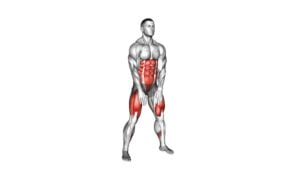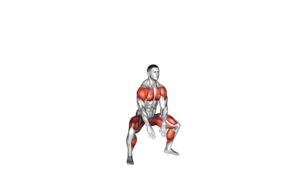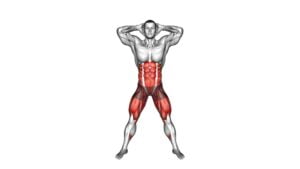In and Out Squat – Video Exercise Guide & Tips

Are you looking to tone your legs and improve your lower body strength? Look no further than the in and out squat!
Watch This Exercise Video
This video exercise guide will show you how to properly perform this effective exercise, along with helpful tips to maximize your results. Whether you're a beginner or advanced, this exercise can be modified to meet your fitness level.
Get ready to feel the burn and take your workouts to the next level with the in and out squat. Let's get started!
Key Takeaways
- The In and Out Squat strengthens lower body muscles and reduces the risk of injuries.
- It burns more calories compared to isolated exercises and boosts metabolism for weight loss or maintenance.
- The exercise adds variety and challenge to lower body workouts.
- Proper form and technique, such as maintaining a neutral spine and engaging core muscles, are crucial for maximizing the benefits of the In and Out Squat.
Benefits of the In and Out Squat
You can gain strength and improve your lower body muscles by incorporating in and out squats into your workout routine. In addition to building muscle, in and out squats offer several other benefits that can enhance your overall fitness.
One key advantage is injury prevention. By performing in and out squats, you engage multiple muscles in your legs, including the quadriceps, hamstrings, and glutes. Strengthening these muscles can help stabilize your knees and hips, reducing the risk of common injuries like strains and sprains.
Another benefit of in and out squats is their ability to burn calories. This compound exercise targets large muscle groups, causing your heart rate to increase and making your body work harder. As a result, you burn more calories compared to isolated exercises. Incorporating in and out squats into your workout routine can be an effective way to boost your metabolism and aid in weight loss or maintenance.
To maximize the benefits of in and out squats, it's important to maintain proper form. Start by standing with your feet shoulder-width apart. Lower your body into a squat position, keeping your knees aligned with your toes. Then, jump out into a wider squat position and immediately jump back to the starting position. Repeat the movement for the desired number of repetitions.
Incorporating in and out squats into your workout routine can help you prevent injuries and burn calories effectively. Adding variety to your lower body exercises can keep your workouts interesting and challenging. Remember to consult with a fitness professional before starting any new exercise program to ensure safety and proper technique.
Proper Form and Technique
To perform the In and Out Squat with proper form and technique, it's important to avoid common mistakes that can lead to injury or ineffective results.
Maintain a neutral spine throughout the movement, keeping your chest up and shoulders back.
Additionally, focus on maximizing muscle activation by engaging your glutes, quads, and hamstrings with each repetition.
Avoiding Common Mistakes
To ensure proper form and technique when performing the In and Out Squat exercise, it's crucially important to consistently practice and focus on maintaining correct alignment throughout the movement.
One common misconception is that you should let your knees collapse inward as you squat down. This can put unnecessary stress on your knees and increase the risk of injury. Instead, make sure to keep your knees in line with your toes throughout the entire movement.
Another mistake to avoid is rounding your back or hunching your shoulders forward. This can strain your lower back and lead to discomfort or injury. Remember to keep your back straight and engage your core muscles to maintain proper alignment.
Maximizing Muscle Activation
To maximize muscle activation and ensure proper form and technique during the In and Out Squat exercise, it's important to maintain correct alignment and avoid common mistakes discussed in the previous subtopic. Improving squat depth is crucial for targeting the muscles in your lower body effectively.
Start by standing with your feet shoulder-width apart and toes pointing slightly outward. As you lower into the squat position, focus on keeping your knees aligned with your toes and your back straight. Engage your core and glutes to enhance lower body strength. Remember to keep your weight on your heels and push through them as you rise back up.
By maintaining proper form and technique, you can maximize muscle activation and achieve better results from your In and Out Squat routine.
Now, let's move on to the equipment needed for the exercise.
Equipment Needed for the Exercise
You will need equipment for the In and Out Squat exercise. This exercise is a great way to target your lower body muscles and improve your strength and endurance. There are different variations of in and out squats that you can try, such as using dumbbells or a resistance band to add extra resistance.
When it comes to equipment alternatives for in and out squats, you have a few options. If you don't have access to dumbbells, you can use water bottles or canned goods as makeshift weights. These may not provide as much resistance as dumbbells, but they can still help you challenge your muscles. Another alternative is to use a resistance band. This lightweight and portable piece of equipment can be easily incorporated into your in and out squat routine. Simply step on the band, hold the handles, and perform the exercise as usual.
Modifications and Progressions
To modify and progress the in and out squat exercise, incorporate variations that challenge your muscles and increase the intensity of the movement. Here are three advanced variations you can try to take your in and out squats to the next level:
- Jump Squats: Instead of just stepping in and out, add a jump to the movement. Start in a squat position, then explode upwards, jumping off the ground. Land softly back into the squat position and repeat.
- Weighted Squats: Hold a dumbbell or kettlebell in front of your chest as you perform the in and out squats. The added weight will increase the resistance and make the exercise more challenging for your muscles.
- Plyometric In and Out Squats: This variation combines the in and out squat with a plyometric movement. Start in the squat position, then explosively jump outwards, spreading your legs wide. Quickly jump back into the squat position and repeat.
Remember to always maintain proper form and start with modifications that are suitable for your fitness level. As you become more comfortable and stronger, gradually progress to more advanced variations to continue challenging your muscles and improving your overall fitness.
Common Mistakes to Avoid
Avoid these common mistakes when performing the in and out squat exercise to ensure you're maximizing the benefits of this movement while minimizing the risk of injuries.
Improving your balance is a key aspect of this exercise, so it's important to maintain proper form throughout.
One common mistake to avoid is allowing your knees to collapse inward during the squat. This can put excessive strain on your knees and increase the risk of injury. Instead, focus on keeping your knees in line with your toes throughout the movement.
Another mistake to avoid is rounding your back or hunching over. This can put unnecessary pressure on your spine and increase the risk of back injuries. Instead, keep your chest up, shoulders back, and maintain a neutral spine.
Lastly, avoid rushing through the exercise. It's important to perform the in and out squat with control and precision to fully engage the muscles and improve your balance. Take your time and focus on proper form to get the most out of this exercise while avoiding injuries.
Tips for Incorporating the in and Out Squat Into Your Routine
To effectively incorporate the in and out squat into your routine, it's important to focus on proper form techniques. This includes maintaining a neutral spine, engaging your core, and squatting down low enough to engage your glutes and thighs.
Additionally, incorporating variations of the in and out squat can help keep your workouts challenging and prevent boredom.
Lastly, consider the frequency and progression of the exercise to ensure you're continually challenging your muscles and making progress in your fitness journey.
Proper Form Techniques
When performing the in and out squat, focus on maintaining proper form by keeping your knees aligned with your toes. This is crucial to prevent common errors such as knee pain or injury.
To ensure proper muscle engagement and maximize the benefits of this exercise, follow these tips:
- Keep your chest lifted and your core engaged throughout the movement. This will help maintain a neutral spine and prevent any unnecessary strain on your lower back.
- As you squat down, push your hips back and lower yourself until your thighs are parallel to the ground. This will activate your glutes, quads, and hamstrings effectively.
- When pushing back up, engage your glutes and drive through your heels. This will help you maintain stability and power through the movement.
By following these proper form techniques, you can safely and effectively incorporate the in and out squat into your routine.
Now, let's explore the benefits of adding variation to this exercise.
Benefits of Variation
To maximize the benefits of incorporating the in and out squat into your routine, try adding variations that target different muscle groups. By incorporating variations, you can challenge your muscles in new ways and prevent your workout from becoming stagnant.
One variation you can try is the jump squat, which adds an explosive element to the exercise and engages your leg muscles even more.
Another variation is the goblet squat, where you hold a dumbbell or kettlebell in front of your chest as you perform the squat. This variation helps to strengthen your core and upper body in addition to your lower body.
By incorporating these different techniques, you can ensure that you're working all of your major muscle groups and maximizing the benefits of the in and out squat.
Now let's explore the frequency and progression of this exercise.
Frequency and Progression
To incorporate the in and out squat into your routine and make progress, you should gradually increase the frequency of this exercise over time. Start by performing the in and out squat once or twice a week, and as you become more comfortable and experienced, you can add more sessions to your weekly routine.
Increasing the frequency of this exercise will allow your muscles to adapt and grow stronger. Additionally, it's important to gradually increase the intensity of the in and out squat. You can do this by adding weights, such as dumbbells or kettlebells, to make the exercise more challenging.
Remember to listen to your body and avoid pushing yourself too hard, as proper form and technique are crucial for avoiding injury.
Frequently Asked Questions
How Many Calories Can I Burn by Doing the in and Out Squat?
By incorporating the in and out squat into your workout routine, you can burn a significant amount of calories. This exercise engages multiple muscles in your lower body, including your quadriceps, hamstrings, and glutes.
The more intense and explosive your movements, the more calories you'll burn. Additionally, this exercise also helps to improve your cardiovascular endurance and overall strength.
Can the in and Out Squat Help in Getting a Bigger Butt?
The in and out squat, when performed correctly, can help in getting a bigger butt. This exercise targets the glutes, hamstrings, and quads, which are the muscles responsible for shaping and lifting the buttocks.
Are There Any Specific Breathing Techniques to Follow While Performing the in and Out Squat?
When performing the in and out squat, it's important to focus on your breathing techniques and maintaining proper form. By incorporating specific breathing techniques, you can enhance your overall performance and maximize the benefits of this exercise.
Additionally, practicing proper form ensures that you're engaging the correct muscles and minimizing the risk of injury. So, make sure to pay attention to your breath and form while doing the in and out squat for optimal results.
Can the in and Out Squat Exercise Be Harmful for People With Knee or Hip Issues?
The in and out squat exercise can potentially be harmful for people with knee or hip issues. It's important to prioritize injury prevention and modify the exercise accordingly. By making adjustments, such as reducing the depth of the squat or using a wider stance, you can protect your knees and hips while still benefiting from the exercise.
Consult with a fitness professional or physical therapist for specific modifications to suit your individual needs.
How Long Should I Rest Between Sets While Doing the in and Out Squat?
To maximize the benefits of the in and out squat, it's important to rest between sets. Rest duration can vary depending on your fitness level and goals. Generally, it's recommended to rest for about 1-2 minutes between sets.
This allows your muscles to recover and maintain proper form throughout the exercise. Remember to listen to your body and adjust the rest duration as needed.
Conclusion
Incorporating the in and out squat into your exercise routine can offer numerous benefits, such as improved lower body strength and stability.
By following proper form and technique, using the necessary equipment, and avoiding common mistakes, you can maximize the effectiveness of this exercise.
Whether you're a beginner or looking for a challenge, modifications and progressions can be made to suit your fitness level.
Remember to consult with a professional trainer or coach to ensure you're performing the in and out squat correctly and safely.

Author
Years ago, the spark of my life’s passion ignited in my mind the moment I stepped into the local gym for the first time. The inaugural bead of perspiration, the initial endeavor, the very first surge of endorphins, and a sense of pride that washed over me post-workout marked the beginning of my deep-seated interest in strength sports, fitness, and sports nutrition. This very curiosity blossomed rapidly into a profound fascination, propelling me to earn a Master’s degree in Physical Education from the Academy of Physical Education in Krakow, followed by a Sports Manager diploma from the Jagiellonian University. My journey of growth led me to gain more specialized qualifications, such as being a certified personal trainer with a focus on sports dietetics, a lifeguard, and an instructor for wellness and corrective gymnastics. Theoretical knowledge paired seamlessly with practical experience, reinforcing my belief that the transformation of individuals under my guidance was also a reflection of my personal growth. This belief holds true even today. Each day, I strive to push the boundaries and explore new realms. These realms gently elevate me to greater heights. The unique combination of passion for my field and the continuous quest for growth fuels my drive to break new ground.



